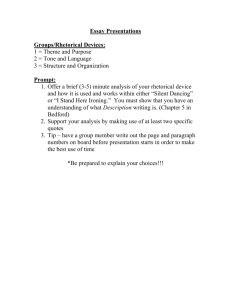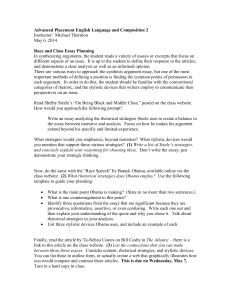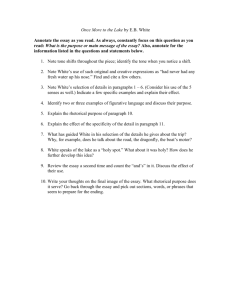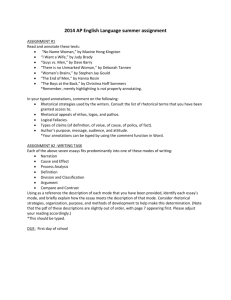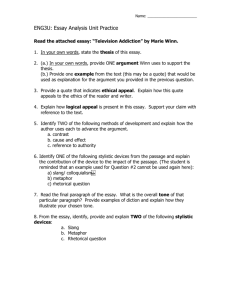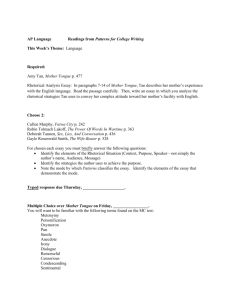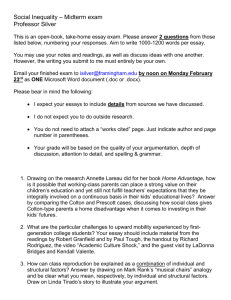UNIT ONE - Central Magnet School
advertisement
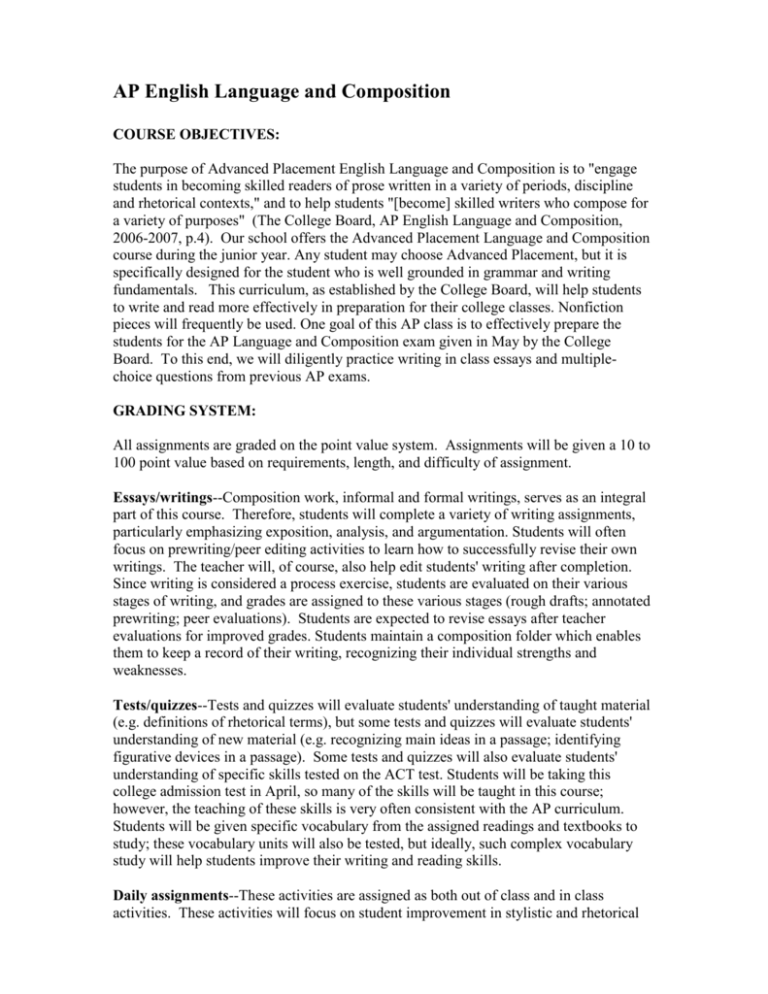
AP English Language and Composition COURSE OBJECTIVES: The purpose of Advanced Placement English Language and Composition is to "engage students in becoming skilled readers of prose written in a variety of periods, discipline and rhetorical contexts," and to help students "[become] skilled writers who compose for a variety of purposes" (The College Board, AP English Language and Composition, 2006-2007, p.4). Our school offers the Advanced Placement Language and Composition course during the junior year. Any student may choose Advanced Placement, but it is specifically designed for the student who is well grounded in grammar and writing fundamentals. This curriculum, as established by the College Board, will help students to write and read more effectively in preparation for their college classes. Nonfiction pieces will frequently be used. One goal of this AP class is to effectively prepare the students for the AP Language and Composition exam given in May by the College Board. To this end, we will diligently practice writing in class essays and multiplechoice questions from previous AP exams. GRADING SYSTEM: All assignments are graded on the point value system. Assignments will be given a 10 to 100 point value based on requirements, length, and difficulty of assignment. Essays/writings--Composition work, informal and formal writings, serves as an integral part of this course. Therefore, students will complete a variety of writing assignments, particularly emphasizing exposition, analysis, and argumentation. Students will often focus on prewriting/peer editing activities to learn how to successfully revise their own writings. The teacher will, of course, also help edit students' writing after completion. Since writing is considered a process exercise, students are evaluated on their various stages of writing, and grades are assigned to these various stages (rough drafts; annotated prewriting; peer evaluations). Students are expected to revise essays after teacher evaluations for improved grades. Students maintain a composition folder which enables them to keep a record of their writing, recognizing their individual strengths and weaknesses. Tests/quizzes--Tests and quizzes will evaluate students' understanding of taught material (e.g. definitions of rhetorical terms), but some tests and quizzes will evaluate students' understanding of new material (e.g. recognizing main ideas in a passage; identifying figurative devices in a passage). Some tests and quizzes will also evaluate students' understanding of specific skills tested on the ACT test. Students will be taking this college admission test in April, so many of the skills will be taught in this course; however, the teaching of these skills is very often consistent with the AP curriculum. Students will be given specific vocabulary from the assigned readings and textbooks to study; these vocabulary units will also be tested, but ideally, such complex vocabulary study will help students improve their writing and reading skills. Daily assignments--These activities are assigned as both out of class and in class activities. These activities will focus on student improvement in stylistic and rhetorical skills. These exercises will be assigned from the Harbrace Handbook and/or teacher prepared handouts. These exercises will be designed to improve student effectiveness in writing as well as preparation for the ACT. Class Texts: Fitzgerald The Great Gatsby Hawthorne The Scarlet Letter Holt McDougal, Elements of Literature, Fifth Course, 2012 Hodges Harbrace Handbook, 15th edition, 2012 Second Edition, 2013 The Language of Composition: McCourt Angela’s Ashes Miller The Crucible Freakonomics Twain The Adventures of Huckleberry Finn Teacher supplementary text: Everyday Use, Roskelly and Jolliffe, AP edition, 2005 INTRODUCTION: WHY TAKE AP? Explanation of Advanced Placement Language and Composition course and curriculum. Introductory letter given to students and parents. Written Assessment: Write an informal essay introducing yourself to the class modeled after Mike Royko's newspaper editorial. Identify "where you stand" on specific social issues, contemporary issues, and trivial issues. Teacher presents her own "Where I Stand" every year as a model. Students revise papers after teacher comments. Oral Assessment: Students read their papers to peers. UNIT ONE: Summer Reading Assessment: AP Language student must read both Angela’s Ashes and Freakonomics during the summer. Written Assessment: Students must write paragraph "connections" between six significant characters, quotes, settings, etc. Students choose six from a list of approximately fifteen terms provided. Oral Assessment: Students in four groups choose a passage from Angela’s Ashes. This passage must be of significant length, two-three pages. The students must provide the passage for all students in class. The students plan, lead, and participate in a Socratic seminar/inner-outer circle discussion focusing on the writer's use of diction to reveal speaker's epiphany. Methods of annotation will be discussed. Stylistic lessons: Students will be given various daily assignments related to diction, connotation; denotation; colloquial/slang; inclusive language. Written Assignment: Students write a personal "epiphany" memoir as out of class writing with rough draft/preliminary work required. Students will revise after teacher comments. Readings: The Jilting of Granny Weatherall In Search of our Mother’s Gardens "Shame," Gregory--nonfiction memoir "Back to School," Lee--New Yorker nonfiction personal memoir Text Excerpts: The Autobiography of Benjamin Franklin Self Reliance, Emerson Nature, Emerson Narrative of the life of Frederick Douglas Autobiography of Mark Twain Stylistic lessons: Students begin analysis of figurative language/sentence structure techniques contrasting Lee's and Gregory's pieces. After answering questions class will discuss implications of author's stylistic choices. Visual Learning: Students will explore photographs of toys and television shows popular in the 1990’s during their childhoods. Students will create a "found" poem. Students will create a pictorial representation of their "found" poems (collage; original artwork; photos) UNIT TWO: Rhetorical Triangle and Ethos/Pathos/ Logos Great Speeches and Letters Analyzed Using Rhetorical Triangle Letter from the Birmingham Jail, King Appeal to Action, Henry Necessary to Protect Ourselves, Malcolm X Civil Disobedience, Thoreau On Civil Disobedience, Gandhi Gettysburg Address, Lincoln Emancipation Proclamation, Lincoln Lou Gehrig’s Speech George Bush 9/11 Kennedy’s Innagrual Address Queen Elizabeth Addressing the Troops at Tilbury Churchill’s Blood, Sweat, and Tears Nixon’s Checker’s Speech Persuasive Writing- Using Ethos/Pathos/Logos persuade your parents to buy you a car. Class Activity-Potato Chip Sampling-In four groups, sample a variety of potato chips in class. Persuade that Brand X is best using rhetorical strategies. UNIT THREE: THE AMERICAN DREAM: ANCHORED (AND BURDENED) BY OUR TRADITIONS Readings: The Scarlet Letter, Hawthorne "Why Guilt is Good," Goodman--nonfiction editorial "Sinners in the Hands of an Angry God," Edwards (textbook) Visual/Auditory Learning and Written Assessment: Students will focus in Scarlet Letter on mood and characterization, focusing on chapters 1, 10, 11, 12, 23. Students will write a short essay comparing either Munch's The Scream/Rachmanioff musical selection/Frost's "Acquainted with the Night" to Dimmesdale's guilt, remorse, and confusion in chapter 12. Oral/Written Assessment: Students will role-play an abbreviated trial to determine the "guiltiest" in sin in Scarlet Letter. Students will work in groups presenting and writing arguments to convict Hester (or) Dimmesdale (or) Chillingworth (or) Puritan society. Teacher will serve as judge to evaluate "best" proven evidence and argument. Rhetorical Lessons: Students will begin exploration of persuasive/rhetorical devices through Edwards' sermon and discuss various devices found in speech. Students will complete daily lesson assignments using the sermon as basis for identifying rhetorical/figurative devices. Stylistic Lessons: Students will discuss and do daily lessons on figurative/stylistic devices in Hawthorne’s piece. Students will continue to focus on diction use and be introduced to syntactical variety in readings. Students will note specific use of details to develop piece. Visual Learning: Students will examine scenes of nature inspired by specific lines from Hawthorne's piece and connect to figurative devices and their effectiveness. Written Assignment: Students write on Gary Soto essay from AP exam, 1996. Students write rough draft as in class essay and peer edit according to evaluation form. Students examine student models from previous exams. UNIT FOUR: Readings: The Crucible, Miller "Why I Wrote The Crucible," Miller "The Trial of Martha Carrier," Mather (nonfiction piece) Oral assessment: Students choose two significant scenes from The Crucible and present to class, also leading class in discussion relating points to main theme of man vs. authority. Students will define McCarthyism and note the social and political conditions of the time-does historical lens color understanding? Written assessment: Students will write out of class assignment responding to one of two well-known quotes: "Power corrupts. Absolute power corrupts absolutely." or "All it takes for evil to flourish is for good men to do nothing." Students will write this paper in stages requiring students to complete peer editing on first draft (handout three, peer revision, teacher created). Students will integrate literary quotes from The Crucible correctly into analysis. Students will revise after teacher comments. Readings: Declaration of Independence, Jefferson (textbook) Rhetorical/Stylistic Lessons: Students will be introduced to inductive and deductive reasoning, review the purposes of rhetoric, consideration of audience; persuasive techniques; fallacies; Students will recognize the purposes of editing by examining the text of Declaration of Independence in textbook and noting the revisions Jefferson was forced to make by the other convention delegates. Visual learning: Students will complete daily assignments using current magazine advertisements to target audience appeals and types of fallacies. (PETA, MADD, tobacco company ads, weight loss, liquor, and fast food ads will be used.) Written assessment: Students will identify audience/types of appeals by writing an explanation to three different audiences--explaining a failing grade to 1)another student 2) a parent 3) a teacher. Teacher will respond informally to this writing by comments in class on oral reading or on assignment. Visual learning: Students need to examine several historical paintings in relation to time period : Henry Arguing the Parson's Cause, Cooke (textbook) Signing of the Declaration of Independence, Trumbull (textbook) Students will discuss characters in relation to purpose of the action-lighting, placement of characters. Students will create a photo essay on “Independence.”. UNIT FIVE: The Gothic and the Grotesque-Why Do We Enjoy Being Frightened? Readings: Fall of the House of Usher, Poe The Masque of the Red Death, Poe The Raven, Poe Danse Macabre, King Anne Rice excerpt The Devil and Tom Walker Liza Lou and the Yellow Bellied Swamp A Rose for Emily Thanatopsis Stylistic lessons: Students will continue to identify figurative/rhetorical devices from speeches and clarify tone consideration of audience. Students are further introduced to the rhetorical devices of concession; refutation; syllogism; qualification and stylistic devices of anaphora, parallelism, pronoun references. Written Assessment: 1. Students will persuade the class using rhetorical devices learned of the most influential horror movie of all time. 2. Students will write a mini-synthesis work using zombies. UNIT SIX: American Controversy Columnist Project- Students will choose six columns from one columnist and write a précis summarizing the columns and a one paragraph reaction to them. Students will then write an argumentative essay by developing an argument inspired through “conversations” with the columnist. Oral Assessment: Students will participate in debate forum. In groups, students choose specific contemporary topics and prepare to debate the opposition. Students are required to find at least three articles from academic journals as support; complete a survey of representative sampling of focus group; interview with authoritative figure on topic. In the speech, students are expected to mention various sources as practice for synthesis essay. Students are required to submit a works cited page following MLA guidelines provided. Students present debates as well as visual support--students must present survey numbers in visual form--i.e. charts; graphs. Written Assessment: Students continue to practice for state wide writing assignment, TCAP, which requires students to defend a specific position on specified argumentative topic. Students will examine models from sample state writings--students participate in "Olympic" judging on models holding up scores after group discussions. Readings: Inherit the Wind, Lawrence and Lee Editorials from local newspaper The Tennessean Minimum of two journal/paper/magazine articles arguing the merits of teaching theories of Darwin's evolutionary theories and Intelligent Design Written Assessment: Students are asked to write a letter to the editor arguing for/against teaching of Darwinism/ID, but students must take the contradictory side from their own personal beliefs. Teacher has determined their belief before assignment is given. THE GREAT DEBATE- the class will participate in a debate consideringclaim/reason/effects/warrant/evidence/significance/audience on Darwin’s evolutionary theories and Intelligent Design Written Assessment: Students will annotate Douglass' passage from 1988 AP exam, highlighting effective figurative language/syntax UNIT SEVEN: SATIRE Readings: A Modest Proposal, Swift The Adventures of Huckleberry Finn, Twain The Onion Stephen Colbert/Jon Stewart Oral assessment: Students will focus on satire as tone in novel and work in groups in identify six targets of satire seen in Twain's writing. Students will analyze methods of developing satire, especially irony and point of view. Students present information in oral presentations. Visual Learning: Students will identify political cartoons from news editorial pages and write a paragraph identifying the target of the satire; the intended audience; the effectiveness of the satire. Teacher will respond informally to students' written paragraphs and present to class. Written assessment: Students will write a persuasive essay on chapter 31 climax of Huck Finn. Students will respond to their own personal opinion on the validity of breaking laws: Is there a current law that they believe is unjust and, therefore, can be challenged? Students may choose either side to support/refute--or qualify. Students will need to cite two other reading sources as support/refutation. Teacher will respond to student's strength of argument in evaluation. Written assessment: Students will write an in class essay on the 2005 question from The Onion on satirical commentary. Students will be evaluated on recognizing the rhetorical devices in satire and the effective use of tone. Students will be graded holistically. Visual Learning: Adventures of Huckleberry Finn, Disney Pictures, starring Elijah Wood, Courtney Vance. Students watch segmented scene of the "funeral" of Wilks. Students comment on the use of satire as seen in film/contrast with depiction in novel. Stylistic Lessons: Students will continue to work on syntactic variety by recognizing this technique in authors' sentences. Teacher provides "cut-up" sentences from wellknown novels/stories, and students will combine these "cut-up" sections. Teacher will focus on teaching various forms, such as appositive phrases, participial phrases, absolute phrases, coordination, and subordination. UNIT EIGHT: Readings: The Great Gatsby, Fitzgerald "The Company Man," Goodman--AP essay/editorial "My mother is not surprised…," Rodriquez--AP essay (1991) "Richard Cory," Robinson (textbook) Written Assignment: Class will discuss their views of the title of the novel. Students will take on the persona of one of the assigned characters in Gatsby and defend/refute Gatsby as "great." Choose a character: Nick Carraway; Daisy Buchanan; Tom Buchanan; Gatsby's father; Owl Eyes. Students will be evaluated on their success in proving their thesis, using support from novel, and writing in appropriate persona. Written Assignment: Students will annotate either Goodman essay/Rodriquez essay; highlighting specific rhetorical/figurative/stylistic devices as prewriting exercise. Oral Assignment: Students will complete abbreviated research in groups on one of the major 1920's issues: 1) fashion; 2) music; 3) sports; 4) politics; 5)criminals; 6)movies; 7) transportation. Students present a works cited page with at least three journals/scholarly articles on topic. Students present information with appropriate visuals, either PowerPoint, poster board. Students bring music, wear fashions, and cook food to celebrate a 1920's speak easy party. Written Assignment: Students will write on the 2006 AP Price essay on the pink flamingo. Student papers will be graded holistically.. UNIT NINE: Research Paper--synthesis paper 1. Students will choose a contemporary, social, controversial issue from list prepared by teacher. 2. Students will gather at least six sources from academic journals, online sources, newspapers, and visuals. Students will highlight, annotate information on reading sources for support/refutation/concession. Students are encouraged to address opposing viewpoints and use such sources within arguments. 3. Students will make printed copies of the sources used in final product. 4. Students will formulate a specific, focused, pointed thesis as argument for research paper. 5. Students will write a research paper of 1200-1500 words integrating six sources and personal claims, assertions within the paper. Students must be practiced in the art of writing a "subjective" research paper with a clear sense of personal voice supported by authoritative sources. 6. Students will accurately attribute citations, using MLA form. 7. Students will write an accurate Works Cited page using MLA form. AP Practice test given under timed conditions UNIT TEN: I Hear America Singing-Poetry and Short Stories Selected works from- Emily Dickenson, Walt Whitman, Robert Frost, writers of the Harlem Renaissance, Eudora Welty and Flannery O’Connor will be enjoyed after AP testing. Diction worksheet (handout one sample) I. Choose the more vivid word choice. The whole surface of the ice was (a chaos, full) of movement. It looked like an enormous (mass, jigsaw puzzle) stretching away to infinity and being (crunched, pushed) together by some invisible but irresistible force. The impression of its (titanic, great) power was heightened by the unhurried deliberations of the motion. Whenever two thick (pieces, floes) came together, their edges (met, collided) and (moved, ground) against one another for a time. Then, when neither of them showed signs of yielding, they rose (uncertainly, quiveringly) driven by the (implacable, tremendous) power behind them. Sometimes they would stop (altogether, abruptly) as the unseen forces affecting the ice appeared mysteriously to lose interest. More frequently, though, the two floes, often ten feet thick or more, would continue to rise, (rearing up, tenting up) until one or both of them toppled over, creating a pressure ridge. II. Place a 1 by the word with the most favorable connotation; 2 by the word with a neutral connotation; and 3 by the least favorable. 1. ill___________ sick____________ diseased_______________ 2. decay________ rot_____________ decompose_____________ 3.garbage_____________ rubbish______________ trash_______________ 4. stern____________ severe_______________ harsh______________ 5. abnormal______________ eccentric_______________ peculiar_____________ 6. aged______________ mellow_______________ mature_____________ 7. request____________ solicit______________ beg_____________ 8. watch______________ ogle________________ stare______________ 9. ignorant_____________ dumb_______________ 10. puny______________ small__________________little________________ III. uninformed________________ Replace the slang expressions with more exact, precise expressions 1. After the ceremony, the guests and the officers of the society stood in the hallway shooting the breeze. 2. When I was a kid, parents knew how to maintain discipline. 3. Because of unexpected rain, the parade commemorating the founding of the city was a flop. 4. Macbeth got mad when he realized his followers were deserting him. 5. I found the objective part of the exam easy, but the essay part threw me. 6. The investors took him to court, claiming that they had been had. 7. My friend, Carol, gave up the job because it caused constant hassles at home. Course Vocabulary, Allusions, and Terminology: First Quarter: 1. Abandon hope, all ye who enter here 2. Ad infinitum 3. All animals are equal, but some animals are more equal than others 4. All that glitters is not gold 5. Angst 6. Apocryphal 7. Anaphora 8. Archetype 9. Bacchanalian 10. Begging the question 11. Beware of Greeks bearing gifts 12. Bite the dust 13. Bread and circuses 14. Caricature 15. Catch-22 16. Circumlocution 17. Conceit 18. Coda 19. Crossing the Rubicon 20. Date which will live in infamy 21. Denotation 22. Didactic 23. Elegiac 24. Ethos 25. Exposition 26. 15 minutes of fames 27. From the sublime to the ridiculous is but a step 28. Genre 29. Golden calf 30. Mrs. Grundy 31. Holy Grail 32. Internal Monologue 33. Indefinite article 34. I think, therefore I am. 35. Juggernaut 36. Lemmings to the sea 37. Lodestone 38. Loaves and fishes 39. Magnum opus 40. Meet one’s Waterloo 41. Milieu 42. NIMBY 43. O Brave New World 44. Ombudsmen 45. Oxymoron 46. Pathos 47. Philistinism 48. Pyrrhic Victory 49. Predestination 50. Purple passage 51. Real politik 52. Rhetorical question 53. Scapegoat 54. Secular 55. Seven deadly sins 56. Secular 57. Stereotype 58. Skeleton in the closet 59. Syllogism 60. Throw down the gauntlet 61. Xanadu 62. Wheel of Fortune Second Quarter: 1. Ad absurdum 2. Agnosticism 3. Allegory 4. Allusion 5. Annus mirabilis 6. Apostrophe (O) 7. Baker’s dozen 8. Benedict Arnold 9. Beware the Ides of March 10. Burning Bush 11. Cain and Abel 12. Chip on one’s shoulder 13. Chiasmus 14. Cock and bull 15. Conspicuous consumption 16. Dickensian 17. Draconian 18. Ellipsis 19. Erudite tone 20. Fireside chat 21. Running the gamut 22. Grotesque 23. Good fences make good neighbors 24. Gordian knot 25. Hope springs eternal 26. It was the best of times, it was the worst of times 27. Luddite 28. Janus 29. Muses 30. Methuselah 31. Muckraker 32. Nemesis 33. Once in a blue moon 34. Panacea 35. Pastoral 36. Pass the buck 37. Persona non grata 38. Primogeniture 39. Quasi 40. Red herring 41. Salem witch trials 42. Scarlet letter 43. Seize the day 44. Sic 45. Scheherazade 46. Sovereignty 47. Stoicism 48. Shibboleth 49. Sour grapes 50. Summa cum laude 51. Sword of Damocles 52. Tower of Babel 53. Surrealism 54. Xenophobia Third Quarter1. Ad hoc 2. Albatross around one’s neck 3. Alter ego 4. Anaphora 5. Anthropomorphism 6. Asymmetry 7. Baroque 8. Bedlam 9. Best laid plans of mice and men oft’ go awry 10. Big brother is watching you 11. Bowdlerize 12. Buying a pig in a poke 13. Chutzpah 14. Cassandra 15. Coals to Newcastle 16. Colloquial 17. Crème de la crème 18. Cultivate one’s garden 19. Delphic oracle 20. Emperor’s new clothes 21. Euphemism 22. Expletive 23. Freudian slip 24. Handwriting on the wall 25. Icarian 26. Indian summer 27. Invective 28. Ivory tower 29. Laugh and the world laughs with you; weep, and you weep alone 30. Lot’s wife 31. Kafkaesque 32. Malapropism 33. Memento mori 34. Murphy’s law 35. Noble savage 36. Oratory 37. On tenterhooks 38. Pandora’s box 39. Prose 40. Pavlovian 41. Pharisaical 42. Pass the buck 43. Pollyanna 44. Poetic justice 45. Postulate 46. Procrustes’ bed 47. Quixotic 48. Redundancy 49. A rose is a rose is a rose 50. Salt of the earth 51. Scrooge 52. Semantics 53. Sound and fury 54. Stratification 55. Synecdoche 56. Sold down the river 57. Superego 58. Tantalus 59. Utopianism 60. Zeitgeist Fourth Quarter 1. Ad hominem 2. Al fresco 3. All roads lead to Rome 4. American Gothic (image) 5. Aphorism 6. Anecdote 7. Augean stables 8. Bas-relief 9. Bildungsroman 10. Byronic 11. Cast pearls before swine 12. Cacophony 13. Cliché 14. Crocodile tears 15. Damn with faint praise 16. Double entendre 17. Ecumenism 18. Ex cathedra 19. Fiddle while Rome burns 20. For whom the bell tolls 21. Gather ye rosebuds while ye may 22. Goethe’s Faust 23. Hoist with his own petard 24. In media res 25. Left-handed compliment 26. Juxtaposition 27. Magna cum laude 28. A man’s reach should exceed his grasp 29. Metonymy 30. Narcissism 31. No man is an island 32. Over a barrel 33. Paradigm 34. Parody 35. Pickwickian 36. Poet Laureate 37. Promethean 38. Pound of flesh 39. Pulitzer Prize 40. Read the riot act 41. Renaissance man 42. Sacred cow 43. Sangfroid 44. Sturm und Drang 45. Scylla and Charybdis 46. Simper fidelis 47. Sisyphean 48. Svengali 49. Stealing someone’s thunder 50. Staccato 51. Stream of consciousness 52. Syntax 53. Taboo 54. Tilting at windmills 55. Watershed 56. White elephant 57. Thirty pieces of silver
